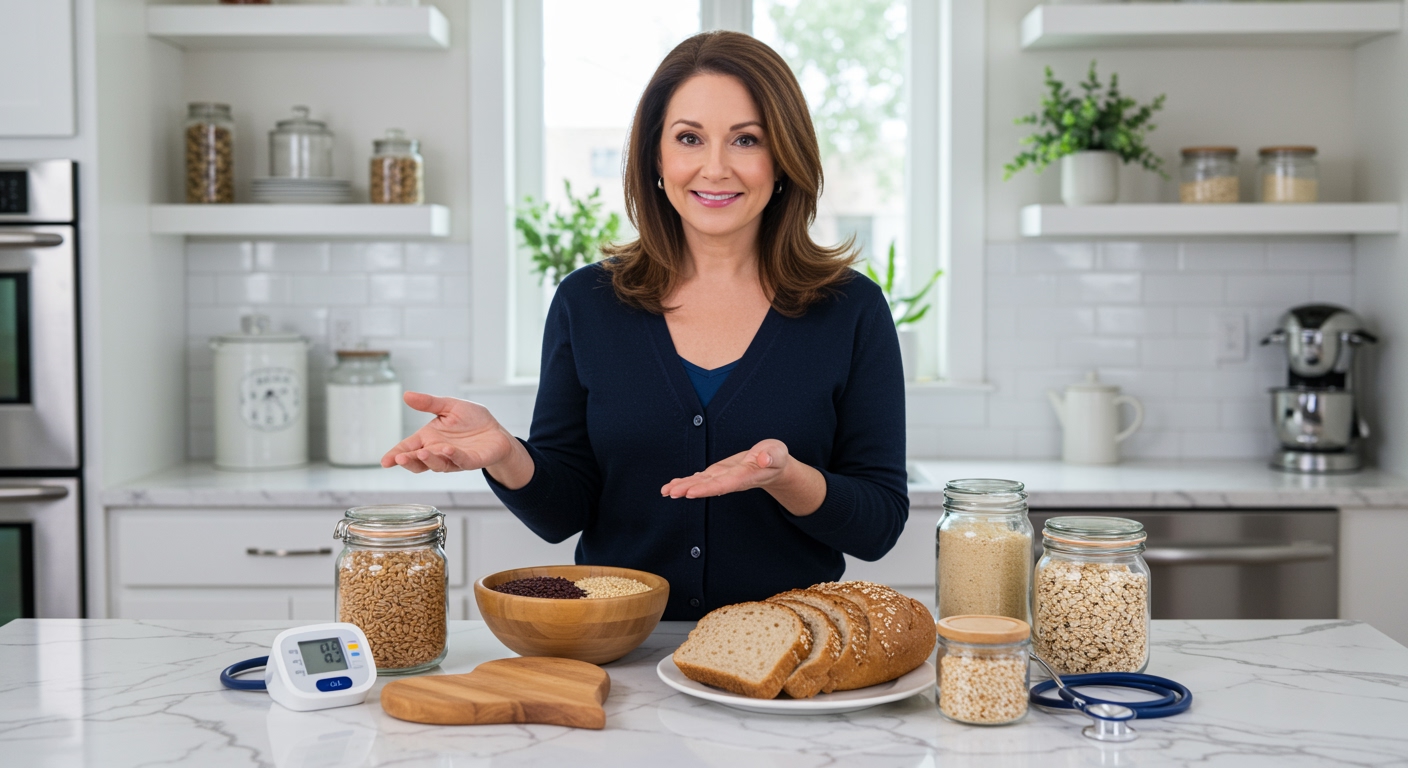✪ Key Takeaway: Whole grains can lower blood pressure by 2-5 mmHg through fiber, magnesium, and potassium content.
Introduction
Your morning toast choice might be silently affecting your blood pressure right now.
You probably wonder if switching from white bread to whole grain products will actually make a difference for your cardiovascular health. Many people ask this question because they want natural ways to support healthy blood pressure without relying solely on medications.
Hi, I’m Abdur, your nutrition coach and today I’m going to explain how whole grains can become a powerful tool in your blood pressure management strategy.
How Do Whole Grains Actually Lower Blood Pressure?
Whole grains work through multiple mechanisms to help reduce blood pressure naturally. The fiber content in whole grains plays a crucial role by binding to sodium in your digestive system and helping your body eliminate excess salt through waste.
Research shows that people who eat three servings of whole grains daily experience a 2-5 mmHg reduction in systolic blood pressure compared to those eating refined grains. This reduction might seem small, but it translates to a 10-15% lower risk of stroke and heart disease.
The magnesium found abundantly in whole grains acts as a natural calcium channel blocker at the cellular level. This mineral helps relax the smooth muscle cells in your blood vessel walls, allowing arteries to dilate and reducing the pressure needed to pump blood through your circulatory system.
Whole grains also contain potassium, which works directly with your kidneys to balance sodium levels in your bloodstream. When potassium levels are adequate, your kidneys can more effectively filter excess sodium, preventing fluid retention that contributes to elevated blood pressure.
The antioxidants in whole grains, particularly phenolic compounds, help protect your blood vessels from oxidative stress and inflammation. These compounds maintain the flexibility of arterial walls, preventing the stiffening that often leads to hypertension as we age.
✪ Pro Tip: Eat whole grains with their bran and germ intact for maximum blood pressure benefits.
Which Whole Grains Are Most Effective for Blood Pressure?
Oats stand out as the most researched whole grain for blood pressure control. The beta-glucan fiber in oats forms a gel-like substance in your digestive tract that slows nutrient absorption and helps stabilize blood sugar levels, indirectly supporting healthy blood pressure.
Studies specifically on oat consumption show that eating 3 grams of oat beta-glucan daily can reduce systolic blood pressure by an average of 3 mmHg. You can get this amount from about one cup of cooked oatmeal or three packets of instant oats.
Brown rice provides excellent magnesium content, with one cup delivering about 20% of your daily magnesium needs. This mineral directly influences blood vessel function and helps maintain the electrical balance needed for proper heart rhythm.
Quinoa offers a complete protein profile along with high potassium levels, making it particularly beneficial for people with hypertension. The protein helps maintain stable blood sugar levels, while potassium supports kidney function and sodium balance.
Whole wheat products contain lignans, plant compounds that have been shown to improve arterial flexibility and reduce inflammation markers associated with cardiovascular disease. Choose products that list whole wheat flour as the first ingredient for maximum benefits.
✪ Fact: Steel-cut oats contain 40% more fiber than rolled oats, making them superior for blood pressure control.
How Much Whole Grain Do You Need Daily?
The optimal amount for blood pressure benefits is three servings of whole grains per day, which equals about 48 grams of whole grains total. One serving equals one slice of whole grain bread, half a cup of cooked brown rice, or one cup of whole grain cereal.
Research indicates that people consuming less than one serving daily show minimal blood pressure improvements, while those eating four or more servings experience the most significant reductions. However, the benefits plateau after about five servings, so more is not necessarily better.
Timing matters for optimal results. Spreading your whole grain intake throughout the day helps maintain steady fiber absorption and provides consistent mineral delivery to your cardiovascular system. This approach also prevents digestive discomfort that can occur with large amounts consumed at once.
Your body needs time to adapt to increased fiber intake, so start with one serving daily and gradually increase over 2-3 weeks. This gradual approach prevents bloating, gas, and other digestive issues that might discourage you from continuing.
People with existing digestive conditions should consult their healthcare provider before significantly increasing whole grain consumption. Some individuals may need to choose refined options temporarily while addressing underlying gut health issues.
✪ Note: Drink extra water when increasing whole grain intake to help fiber work effectively in your system.
What About Refined Grains and Blood Pressure?
Refined grains actually work against healthy blood pressure through several mechanisms. The processing removes the bran and germ, eliminating most of the fiber, magnesium, and potassium that provide cardiovascular benefits.
White bread, white rice, and regular pasta cause rapid spikes in blood sugar levels, triggering insulin release that can contribute to sodium retention and increased blood pressure over time. This effect is particularly pronounced in people with insulin resistance or diabetes.
Studies comparing refined grain consumption to whole grain intake show that people eating primarily refined grains have 2-3 mmHg higher systolic blood pressure on average. This difference compounds over years, significantly increasing cardiovascular disease risk.
The lack of fiber in refined grains also affects your gut microbiome, reducing beneficial bacteria that produce short-chain fatty acids. These compounds help regulate inflammation and support healthy blood vessel function throughout your body.
Many refined grain products contain added sodium for flavor enhancement, further contributing to blood pressure elevation. Reading ingredient labels becomes crucial for identifying these hidden sodium sources in processed foods.
✪ Pro Tip: Replace one refined grain serving with whole grains weekly until you reach three daily servings.
The Bottom Line
Whole grains offer genuine blood pressure benefits through their fiber, magnesium, and potassium content, with research supporting 2-5 mmHg reductions in people who eat three servings daily. “The simplest health changes often create the most lasting results.”
Making the switch from refined to whole grains represents one of the most practical dietary changes you can implement for cardiovascular health. The benefits extend beyond blood pressure to include improved cholesterol levels, better blood sugar control, and reduced inflammation throughout your body.
I would love to hear about your experience with whole grains and any questions you might have about incorporating them into your daily routine. Please share your thoughts in the comments below, and let me know which whole grains you find most enjoyable and practical for your lifestyle.
References
At NutritionCrown, we use quality and credible sources to ensure our content is accurate and trustworthy. Below are the sources referenced in creating this article:





